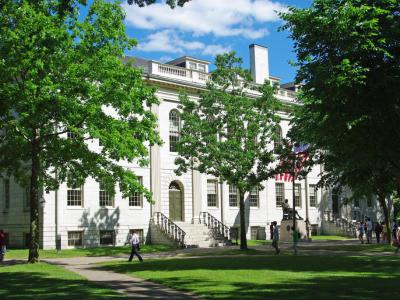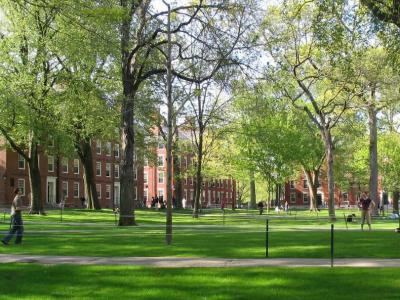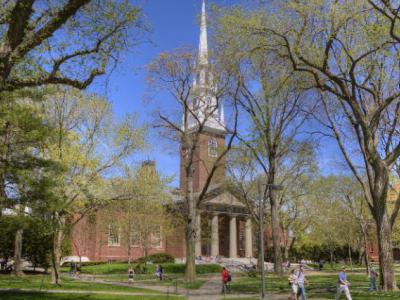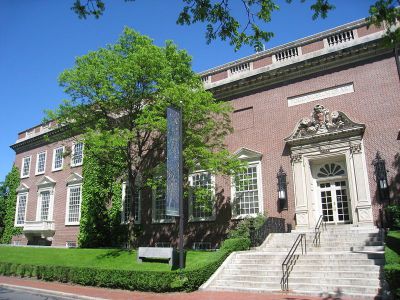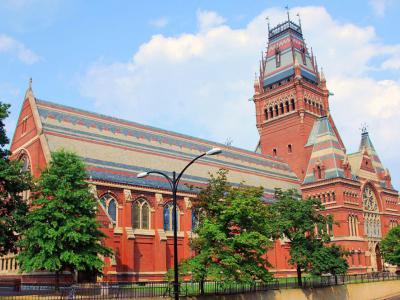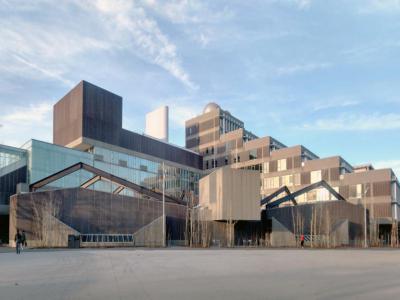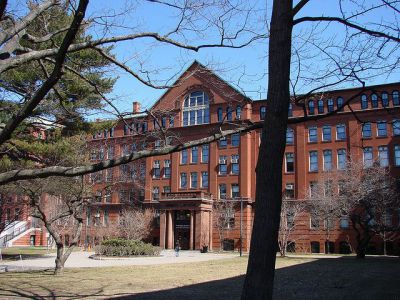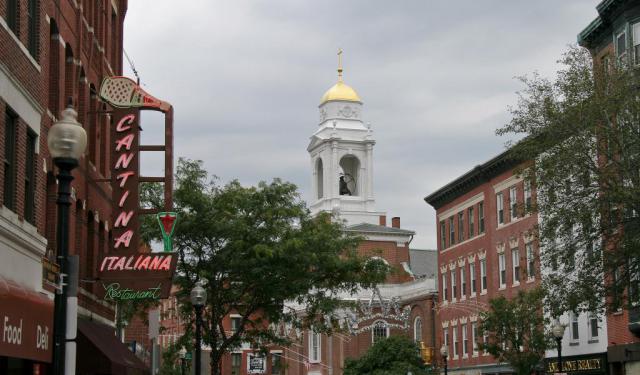
Harvard University Walking Tour (Self Guided), Boston
The United States’ oldest institution of higher education (and, of course, among the most prestigious), Harvard was established in 1636. Reverend John Harvard, who bequeathed his entire library and half of his estate, is the University’s namesake. Presidents, billionaires and Rhodes Scholars are only some of the illustrious graduates; in fact, Harvard has more Nobel Prize-winning alumni, faculty, and researchers than any other university in the world. A true factory of knowledge!
The University’s main campus is centered on Harvard Yard in Cambridge, northwest of Downtown Boston. Its earliest surviving building, dating from 1720, is the Massachusetts Hall, where several founding fathers (John Hancock, Samuel Adams, Elbridge Gerry, and James Otis) slept while attending classes. Outside of nearby University Hall, take note of the bronze seated statue of John Harvard, and rub his golden left foot for good luck.
Stroll past the 1916 Widener Library, the largest of Harvard’s dozens of libraries, and don’t miss the Memorial Church with its lovely light interior. Further along the way, the Gothic-Revival Memorial Hall/Lowell Complex was constructed in the 1870s to honor those men who served in the Civil War. Do enter the majestic building and view the colorful, stunning stained-glass windows, both by prominent artisans: Tiffany and La Farge.
With wonderful architecture and infrastructure focused on the production of knowledge, this place is a must visit! Take our self-guided walking tour to visit the historical places on the Harvard campus and get a glimpse into the student life in this world-famous university.
The University’s main campus is centered on Harvard Yard in Cambridge, northwest of Downtown Boston. Its earliest surviving building, dating from 1720, is the Massachusetts Hall, where several founding fathers (John Hancock, Samuel Adams, Elbridge Gerry, and James Otis) slept while attending classes. Outside of nearby University Hall, take note of the bronze seated statue of John Harvard, and rub his golden left foot for good luck.
Stroll past the 1916 Widener Library, the largest of Harvard’s dozens of libraries, and don’t miss the Memorial Church with its lovely light interior. Further along the way, the Gothic-Revival Memorial Hall/Lowell Complex was constructed in the 1870s to honor those men who served in the Civil War. Do enter the majestic building and view the colorful, stunning stained-glass windows, both by prominent artisans: Tiffany and La Farge.
With wonderful architecture and infrastructure focused on the production of knowledge, this place is a must visit! Take our self-guided walking tour to visit the historical places on the Harvard campus and get a glimpse into the student life in this world-famous university.
How it works: Download the app "GPSmyCity: Walks in 1K+ Cities" from Apple App Store or Google Play Store to your mobile phone or tablet. The app turns your mobile device into a personal tour guide and its built-in GPS navigation functions guide you from one tour stop to next. The app works offline, so no data plan is needed when traveling abroad.
Harvard University Walking Tour Map
Guide Name: Harvard University Walking Tour
Guide Location: USA » Boston (See other walking tours in Boston)
Guide Type: Self-guided Walking Tour (Sightseeing)
# of Attractions: 15
Tour Duration: 2 Hour(s)
Travel Distance: 2.3 Km or 1.4 Miles
Author: anna
Sight(s) Featured in This Guide:
Guide Location: USA » Boston (See other walking tours in Boston)
Guide Type: Self-guided Walking Tour (Sightseeing)
# of Attractions: 15
Tour Duration: 2 Hour(s)
Travel Distance: 2.3 Km or 1.4 Miles
Author: anna
Sight(s) Featured in This Guide:
- Harvard Square
- Harvard Hall
- Massachusetts Hall
- University Hall and John Harvard Statue
- Widener Library
- Harvard Yard
- Memorial Church of Harvard University
- Sever Hall
- Harvard Art Museums
- Memorial Hall / Sanders Theatre
- Harvard Science Center
- Peabody Museum of Archaeology and Ethnology
- Harvard Museum of Natural History
- Harvard Law School
- Cambridge Common
1) Harvard Square
Cambridge is kind of like a giant bow tie, with Harvard Square smack in the middle, forming the knot. Harvard University sprawls out from here, and together, they form the brainy and cultural heart of Cambridge. It's where folks flock to check out the famous Ivy League school, soak in some history, savor the lively coffeehouse-and-bookstore scene and a dash of rebellious counterculture. Even though it's just a square mile in size, it's jam-packed with things to do and see, making it a part of town you don't want to skip.
The action mostly goes down in an area known as "The Pit", which is a hub for teens to hang out, flaunt their vibrant green hair, and show off their latest body piercings. It's also the beginning of the street music scene, where talented performers like folk sensation Tracy Chapman and country star Bonnie Raitt got their big breaks. If you're looking for some square-time excitement, aim for Friday and Saturday nights or Sunday afternoons when the place is buzzing – crowds, street performers, and good vibes galore.
When it comes to food, Harvard Square has you covered with an array of restaurants dishing out global flavors. Japanese, American, Italian, Middle Eastern, Korean – you name it, they've got it. If the weather's playing nice, snag a seat in a beer garden or take to the streetside. For a unique experience, check out Daedalus, a spot fashioned from a greenhouse, complete with a heated rooftop bar where you can chill year-round. If ramen's your jam, Hokkaido Ramen at No. 1 Bow Street has communal tables for your noodle feasting pleasure.
Feeling artsy? Catch some indie flicks or top-notch plays at the arthouse theaters around. And hey, if you're up for a mental challenge, they've got outdoor chess sets that see plenty of action.
Tip:
Take a peek at the calendar – you might strike gold and find yourself in Harvard Square during a festival. Winter Carnival, Chinese New Year, Mayfair, and Sparklefest – they all add a little extra sparkle to the seasons.
The action mostly goes down in an area known as "The Pit", which is a hub for teens to hang out, flaunt their vibrant green hair, and show off their latest body piercings. It's also the beginning of the street music scene, where talented performers like folk sensation Tracy Chapman and country star Bonnie Raitt got their big breaks. If you're looking for some square-time excitement, aim for Friday and Saturday nights or Sunday afternoons when the place is buzzing – crowds, street performers, and good vibes galore.
When it comes to food, Harvard Square has you covered with an array of restaurants dishing out global flavors. Japanese, American, Italian, Middle Eastern, Korean – you name it, they've got it. If the weather's playing nice, snag a seat in a beer garden or take to the streetside. For a unique experience, check out Daedalus, a spot fashioned from a greenhouse, complete with a heated rooftop bar where you can chill year-round. If ramen's your jam, Hokkaido Ramen at No. 1 Bow Street has communal tables for your noodle feasting pleasure.
Feeling artsy? Catch some indie flicks or top-notch plays at the arthouse theaters around. And hey, if you're up for a mental challenge, they've got outdoor chess sets that see plenty of action.
Tip:
Take a peek at the calendar – you might strike gold and find yourself in Harvard Square during a festival. Winter Carnival, Chinese New Year, Mayfair, and Sparklefest – they all add a little extra sparkle to the seasons.
2) Harvard Hall
On the north side of Johnston Gate stands Harvard Hall, one of the two campus elders, with a birth certificate dating all the way back to 1766. (The other ancient one is Massachusetts Hall, staring it down from directly across the street.)
Believe it or not, the original building sprouted here in 1672 – but, surprise, surprise, it got demolished a mere eight years later. The second attempt at a building was a bit of a hot mess, both figuratively and literally, as it went up in flames in 1764. This fiery episode took with it thousands of books and fancy scientific instruments that were contained in its library.
But third time's the charm, right? The current Harvard Hall, in all its Georgian-style glory, was constructed between 1764 and 1776 with a mix of brick, granite, and brownstone. And guess who was there during this reconstruction project? None other than Benjamin Franklin himself, offering some pro bono advice on replacing those lost scientific gizmos.
Back in the day, Harvard Hall was the ultimate academic multitasker, having played host to a library, a cafeteria (probably with some seriously ancient mac 'n' cheese), classrooms, and science labs. Over the years, it's undergone more face-lifts than a Hollywood superstar. In 1842, it got a fresh makeover, complete with a two-story porch – very fancy. Then, in 1870, it had another renovation, because why not? And just when you thought Harvard Hall couldn't possibly get any more glamorous, they kicked off another round of renovations in 2019. The exterior got all spruced up to look like it did back in 1870, with brick restoration and some perfectly matched paint. On the inside, they brought in all the modern tech gizmos to keep this historic building feeling fresh and relevant.
So, Harvard Hall might be getting older, but it's still keeping up with the times!
Believe it or not, the original building sprouted here in 1672 – but, surprise, surprise, it got demolished a mere eight years later. The second attempt at a building was a bit of a hot mess, both figuratively and literally, as it went up in flames in 1764. This fiery episode took with it thousands of books and fancy scientific instruments that were contained in its library.
But third time's the charm, right? The current Harvard Hall, in all its Georgian-style glory, was constructed between 1764 and 1776 with a mix of brick, granite, and brownstone. And guess who was there during this reconstruction project? None other than Benjamin Franklin himself, offering some pro bono advice on replacing those lost scientific gizmos.
Back in the day, Harvard Hall was the ultimate academic multitasker, having played host to a library, a cafeteria (probably with some seriously ancient mac 'n' cheese), classrooms, and science labs. Over the years, it's undergone more face-lifts than a Hollywood superstar. In 1842, it got a fresh makeover, complete with a two-story porch – very fancy. Then, in 1870, it had another renovation, because why not? And just when you thought Harvard Hall couldn't possibly get any more glamorous, they kicked off another round of renovations in 2019. The exterior got all spruced up to look like it did back in 1870, with brick restoration and some perfectly matched paint. On the inside, they brought in all the modern tech gizmos to keep this historic building feeling fresh and relevant.
So, Harvard Hall might be getting older, but it's still keeping up with the times!
3) Massachusetts Hall
Massachusetts Hall, the granddaddy of Harvard buildings, has been standing tall since 1720, back when the USA was just a twinkle in the eye of the British Empire. One of the oldest academic structures in the entire country, this architectural relic rocks an Early Georgian style, with red brick walls and white accents that scream "colonial charm."
Originally, it was like the Harvard Hilton, hosting 64 students in 32 chambers (that's just fancy talk for rooms) and 64 tiny studies. But here's where it gets interesting – during the Siege of Boston from 1775 to 1776, this dormitory did double duty as a barracks, housing over 640 American soldiers. It went from scholarly sanctuary to full-on military base real quick.
Now, Massachusetts Hall has played host to some pretty famous folks. We're talking about the founding fathers of the nation, no less. John Adams, who would later become President #2, once called the third floor home sweet home. Founding fathers like John Hancock, Samuel Adams, Elbridge Gerry, and James Otis all pulled up a bunk here while they were hitting the books. These walls practically oozed revolutionary ideas – who needs a lecture hall when you've got heated debates happening in your dorm room?
Today, Massachusetts Hall has gone through a bit of a career change. It's home to the bigwigs of Harvard – the President, Vice President, Treasurer, and Provost all have offices on the first and second floors. Meanwhile, the third floor has gone back to its roots, serving as a dormitory for bright-eyed, bushy-tailed freshmen, because why let a little thing like age slow you down?
Originally, it was like the Harvard Hilton, hosting 64 students in 32 chambers (that's just fancy talk for rooms) and 64 tiny studies. But here's where it gets interesting – during the Siege of Boston from 1775 to 1776, this dormitory did double duty as a barracks, housing over 640 American soldiers. It went from scholarly sanctuary to full-on military base real quick.
Now, Massachusetts Hall has played host to some pretty famous folks. We're talking about the founding fathers of the nation, no less. John Adams, who would later become President #2, once called the third floor home sweet home. Founding fathers like John Hancock, Samuel Adams, Elbridge Gerry, and James Otis all pulled up a bunk here while they were hitting the books. These walls practically oozed revolutionary ideas – who needs a lecture hall when you've got heated debates happening in your dorm room?
Today, Massachusetts Hall has gone through a bit of a career change. It's home to the bigwigs of Harvard – the President, Vice President, Treasurer, and Provost all have offices on the first and second floors. Meanwhile, the third floor has gone back to its roots, serving as a dormitory for bright-eyed, bushy-tailed freshmen, because why let a little thing like age slow you down?
4) University Hall and John Harvard Statue
University Hall is a real showstopper, a building that's determined to stand out in the crowd. Its neoclassical design is the architectural equivalent of a grand entrance – large, imposing, and so symmetrical that it's almost showing off. This beauty was built between 1813 and 1815 from white granite, a real rebel compared to its red brick buddies, Massachusetts Hall and Harvard Hall. And if you need more proof of its superstar status, it's been designated a National Historical Landmark.
Now, let's talk about the other superstar in the yard – the John Harvard Statue. This is the spot where every hopeful Harvard student makes a pilgrimage for that classic photo op. They'll strike a pose next to good ol' John, the guy who's always good for a bit of luck. Legend has it that rubbing his shiny shoe brings you good fortune, and who wouldn't want a piece of that?
The statue, designed by Daniel Chester French, proudly flaunts an inscription that reads, 'John Harvard, Founder of Harvard College, 1638'. Except, here's the twist – none of that is actually true! First of all, the statue doesn't depict John Harvard because nobody really knows what he looked like; it's just some random student who's been hitting the books a little too hard. Second, John Harvard wasn't the founder of the college; he was more like the first generous donor who chipped in back in 1638. And if you want to split hairs, the college was actually founded two years earlier in 1636. So, in essence, the statue is known for telling three big lies.
It's almost as if the Harvard symbol is out here playing a prank on everyone, giving a cheeky wink to the university's motto, 'Veritas', which means 'truth.' But hey, who needs the truth when you've got a shiny shoe to rub for good luck?
Now, let's talk about the other superstar in the yard – the John Harvard Statue. This is the spot where every hopeful Harvard student makes a pilgrimage for that classic photo op. They'll strike a pose next to good ol' John, the guy who's always good for a bit of luck. Legend has it that rubbing his shiny shoe brings you good fortune, and who wouldn't want a piece of that?
The statue, designed by Daniel Chester French, proudly flaunts an inscription that reads, 'John Harvard, Founder of Harvard College, 1638'. Except, here's the twist – none of that is actually true! First of all, the statue doesn't depict John Harvard because nobody really knows what he looked like; it's just some random student who's been hitting the books a little too hard. Second, John Harvard wasn't the founder of the college; he was more like the first generous donor who chipped in back in 1638. And if you want to split hairs, the college was actually founded two years earlier in 1636. So, in essence, the statue is known for telling three big lies.
It's almost as if the Harvard symbol is out here playing a prank on everyone, giving a cheeky wink to the university's motto, 'Veritas', which means 'truth.' But hey, who needs the truth when you've got a shiny shoe to rub for good luck?
5) Widener Library
The Harvard library was built in memory of Harry Elkins Widener, a Harvard grad from way back in 1907 who met his fate on the Titanic. Now, Harry wasn't your average bookworm – he was the kind of guy who'd risk it all for a good read. Legend has it that as the ship was going down, Harry didn't just grab a lifeboat and call it a day. No, he gave up his spot just to rescue his favorite book from his stateroom.
Even though he was just 27 when he met his watery end, Harry had amassed a jaw-dropping collection of books. He was on a mission to collect first editions from all his favorite authors, like Charles Dickens and Robert Louis Stevenson. And in his will, Harry had a literary twist ready – he instructed his mother, Eleanor Widener, to donate this treasure trove to Harvard. And boy, did she take things to the next level! Instead of just building an addition to Harvard's library, she funded a whole new library in his memory.
Unveiled it in 1915, the building is a sight to behold. You could call it Georgian, Beaux-Arts, Hellenistic, or even Imperial, depending on your mood. When you walk up to the entrance, you can't help but feel like you're about to embark on an epic quest with those dramatic stairs and those columns that are so regal they could be knighted.
Inside, there's a maze of bookshelves that stretch for over 50 miles – that's like trying to find your way out of a bookworm's labyrinth. Designed by one of the nation's very first major African American architects, Julian Abele, this library boasts a staggering 3.5 million volumes in a jaw-dropping 450 languages. Unfortunately, it's not open to the public. Sorry, folks, you'll have to admire this bookish beauty from the outside. But hey, don't be sad: you can still admire the outside of this columned wonder, and those steps? Well, they make for a great spot to take a breather during your stroll through history.
Harry, we salute your Titanic-level commitment to literature!
Even though he was just 27 when he met his watery end, Harry had amassed a jaw-dropping collection of books. He was on a mission to collect first editions from all his favorite authors, like Charles Dickens and Robert Louis Stevenson. And in his will, Harry had a literary twist ready – he instructed his mother, Eleanor Widener, to donate this treasure trove to Harvard. And boy, did she take things to the next level! Instead of just building an addition to Harvard's library, she funded a whole new library in his memory.
Unveiled it in 1915, the building is a sight to behold. You could call it Georgian, Beaux-Arts, Hellenistic, or even Imperial, depending on your mood. When you walk up to the entrance, you can't help but feel like you're about to embark on an epic quest with those dramatic stairs and those columns that are so regal they could be knighted.
Inside, there's a maze of bookshelves that stretch for over 50 miles – that's like trying to find your way out of a bookworm's labyrinth. Designed by one of the nation's very first major African American architects, Julian Abele, this library boasts a staggering 3.5 million volumes in a jaw-dropping 450 languages. Unfortunately, it's not open to the public. Sorry, folks, you'll have to admire this bookish beauty from the outside. But hey, don't be sad: you can still admire the outside of this columned wonder, and those steps? Well, they make for a great spot to take a breather during your stroll through history.
Harry, we salute your Titanic-level commitment to literature!
6) Harvard Yard
Harvard Yard is the beating heart of Harvard University's 209-acre campus in good ol' Cambridge. Back in the day, before it became the brainscape it is today, the Yard was just a fancy name for a cow hangout – a real pasture for those bovine scholars. Now, it's got more gates than a medieval castle (27 to be precise), some fresh-faced freshman dorms, several academic buildings, and enough Harvard Library branches to give you paper cuts for days – and they say it's the biggest academic library system in the entire universe.
When you stroll through Harvard Yard, you'll feel like you're in a real-life Harry Potter movie, minus the magic wands. You've got these charming red-brick buildings and lush lawns that scream "we're smarter than you", where the Harvardians of tomorrow come to sharpen their minds and pretend to be grown-ups. It's like a giant study hall with bonus socializing points, and when the grads finally snag their diplomas, it's like the epic finale of an academic reality show.
And if you need a break from all that brainpower, just mosey on over to the Plaza (right outside Bradstreet Gate on the north side) – the campus's cool hangout spot, complete with food trucks, farmers markets, ping-pong tables, and other shenanigans that change with the seasons. So, if you ever find yourself here, bring your thinking cap, your picnic blanket, and your best philosophical questions.
When you stroll through Harvard Yard, you'll feel like you're in a real-life Harry Potter movie, minus the magic wands. You've got these charming red-brick buildings and lush lawns that scream "we're smarter than you", where the Harvardians of tomorrow come to sharpen their minds and pretend to be grown-ups. It's like a giant study hall with bonus socializing points, and when the grads finally snag their diplomas, it's like the epic finale of an academic reality show.
And if you need a break from all that brainpower, just mosey on over to the Plaza (right outside Bradstreet Gate on the north side) – the campus's cool hangout spot, complete with food trucks, farmers markets, ping-pong tables, and other shenanigans that change with the seasons. So, if you ever find yourself here, bring your thinking cap, your picnic blanket, and your best philosophical questions.
7) Memorial Church of Harvard University
Memorial Church in Harvard Yard is like the elegant, tall, and slender cousin to the beefy Widener Library nearby. You can spot it from afar due to the iconic 172-foot steeple, topped by a medieval weathervane that's probably seen its fair share of New England weather.
Venturing inside, you'll find yourself in the nave, where the names of nearly 400 alumni who gave their all in World War I are etched. Right next to these solemn inscriptions, there's a sculpture called 'The Sacrifice' that's bound to tug at your heartstrings. And since it's all about honoring heroes, they've added memorials for alumni lost in later wars too – World War II, the Korean War, and the Vietnam War.
Memorial Church isn't just about remembrance, though. They've got a weekly dose of choral music that'll soothe your soul. If you're an early riser, they've got morning prayers from Monday to Friday. And every Sunday, they're all about bringing people together from different walks of faith for multi-denominational services. If you' need a moment of reflection or inspiration, make a pit stop here!
Venturing inside, you'll find yourself in the nave, where the names of nearly 400 alumni who gave their all in World War I are etched. Right next to these solemn inscriptions, there's a sculpture called 'The Sacrifice' that's bound to tug at your heartstrings. And since it's all about honoring heroes, they've added memorials for alumni lost in later wars too – World War II, the Korean War, and the Vietnam War.
Memorial Church isn't just about remembrance, though. They've got a weekly dose of choral music that'll soothe your soul. If you're an early riser, they've got morning prayers from Monday to Friday. And every Sunday, they're all about bringing people together from different walks of faith for multi-denominational services. If you' need a moment of reflection or inspiration, make a pit stop here!
8) Sever Hall
Sever Hall, finished in 1880 and conceived by the renowned architect Henry Hobson Richardson, exemplifies a distinct architectural trend referred to as the Romanesque revival style. On the Harvard campus, various other styles succeeded it, such as neoclassical, as evident in the grand pillared facade of the Widener Library, and neo-Georgian, beautifully displayed in the elegant brick residences along the Charles River, many of which currently accommodate undergrads.
Ann Sever, in a heartfelt tribute to her late husband James W. Sever, generously gifted this gem. It's not just a pretty face – Sever Hall serves various academic purposes, housing classrooms and offices. You won't believe it, but they threw in over 1.3 million red bricks into the mix when constructing this Historical Landmark. That's some serious LEGO-level dedication! The result showcases the intricate craftsmanship of cut, carved, and molded bricks, complete with semi-turrets, a hipped roof, and ornate carvings.
Oh, and here's the cherry on top – the entrance archway has a neat acoustic trick up its sleeve. Whisper sweet nothings at the bricks in the archway, and your secrets will magically travel 12 feet to the other side. It's like Harvard's very own telephone game!
The famous architecture critic Robert Venturi once declared Sever Hall his favorite building in America. It's had its fair share of glow-ups, with the most recent one in 2005 to keep it looking its best.
Ann Sever, in a heartfelt tribute to her late husband James W. Sever, generously gifted this gem. It's not just a pretty face – Sever Hall serves various academic purposes, housing classrooms and offices. You won't believe it, but they threw in over 1.3 million red bricks into the mix when constructing this Historical Landmark. That's some serious LEGO-level dedication! The result showcases the intricate craftsmanship of cut, carved, and molded bricks, complete with semi-turrets, a hipped roof, and ornate carvings.
Oh, and here's the cherry on top – the entrance archway has a neat acoustic trick up its sleeve. Whisper sweet nothings at the bricks in the archway, and your secrets will magically travel 12 feet to the other side. It's like Harvard's very own telephone game!
The famous architecture critic Robert Venturi once declared Sever Hall his favorite building in America. It's had its fair share of glow-ups, with the most recent one in 2005 to keep it looking its best.
9) Harvard Art Museums
Harvard University's oldest museum, which houses the combined collections of the Busch-Reisinger, Fogg, and Arthur M. Sackler Museums, achieved this merger in late 2014, and the three museums now exist under a splendid, predominantly glass roof. Designed by the acclaimed architect Renzo Piano, the complex spans 204,000 square feet across seven levels, enabling a more comprehensive display of Harvard's extensive 250,000-piece art collection, featuring European and American art spanning from the Middle Ages to present days.
Notable highlights encompass American and European paintings, sculptures, and decorative arts from the Fogg Museum; Asian art, Buddhist cave-temple sculptures, and Chinese bronzes from the Arthur M. Sackler collection; as well as works by German expressionists, materials associated with the Bauhaus, and postwar contemporary art from German-speaking Europe from the Busch-Reisinger Museum.
While retaining the Fogg's central courtyard, designed in the style of a 16th-century Italian Renaissance facade, as its nucleus, the complex extends both upward and outward. Within the courtyard, one can find the admissions desk, a small café, and a gift shop.
Tip:
Exploring the complex is best done from the top down. A recommended starting point is the Lightbox Gallery on Level 5, where visitors can engage with digital projects and delve into the collection. Looking down into the courtyard offers a view of Renzo Piano's ingenious architectural expansion, all while affording an overhead perspective of the expansive Alexander Calder mobile that fills the space. Visitors also have the opportunity to peek into the laboratories of the Straus Center for Conservation and Technical Studies.
Notable highlights encompass American and European paintings, sculptures, and decorative arts from the Fogg Museum; Asian art, Buddhist cave-temple sculptures, and Chinese bronzes from the Arthur M. Sackler collection; as well as works by German expressionists, materials associated with the Bauhaus, and postwar contemporary art from German-speaking Europe from the Busch-Reisinger Museum.
While retaining the Fogg's central courtyard, designed in the style of a 16th-century Italian Renaissance facade, as its nucleus, the complex extends both upward and outward. Within the courtyard, one can find the admissions desk, a small café, and a gift shop.
Tip:
Exploring the complex is best done from the top down. A recommended starting point is the Lightbox Gallery on Level 5, where visitors can engage with digital projects and delve into the collection. Looking down into the courtyard offers a view of Renzo Piano's ingenious architectural expansion, all while affording an overhead perspective of the expansive Alexander Calder mobile that fills the space. Visitors also have the opportunity to peek into the laboratories of the Straus Center for Conservation and Technical Studies.
10) Memorial Hall / Sanders Theatre
One of Harvard's most ancient structures, erected in 1878 as a tribute to the alumni who fought and perished in the Civil War, Memorial Hall boasts nifty pointed arches and flying buttresses. Although its appearance resembles that of a church, complete with a central vaulted narthex illuminated by filtered sunlight streaming through Tiffany and La Farge stained-glass windows, the space actually functions as Sanders Theatre, undeniably Harvard's most impressive venue for concerts. Renowned for its wooden paneling and exceptional acoustics, it hosts year-round classical music performances by local choirs and ensembles, along with occasional concerts featuring jazz and world musicians.
Memorial Hall itself is a circular chamber enclosed by towering columns made of Siena marble, where the original flags carried by Massachusetts soldiers into battle are on display behind transparent panels, and it is illuminated by a vaulted stained-glass window bearing the state seal. On the third floor, suspended above the public gallery in the House of Representatives, hangs a carved wooden fish known as the Sacred Cod, dating back to 1783. This symbol of maritime prosperity is taken so seriously by politicians that, in the 1930s, when Harvard pranksters swiped it, the House refused to convene until it was recovered.
In close proximity, Annenberg Hall, a spacious area primarily used as a dining hall, is decked out with portraits and sculptures of big-shot alumni, basically serving as a motivational hall of fame for all the overachievers at Harvard.
Memorial Hall itself is a circular chamber enclosed by towering columns made of Siena marble, where the original flags carried by Massachusetts soldiers into battle are on display behind transparent panels, and it is illuminated by a vaulted stained-glass window bearing the state seal. On the third floor, suspended above the public gallery in the House of Representatives, hangs a carved wooden fish known as the Sacred Cod, dating back to 1783. This symbol of maritime prosperity is taken so seriously by politicians that, in the 1930s, when Harvard pranksters swiped it, the House refused to convene until it was recovered.
In close proximity, Annenberg Hall, a spacious area primarily used as a dining hall, is decked out with portraits and sculptures of big-shot alumni, basically serving as a motivational hall of fame for all the overachievers at Harvard.
11) Harvard Science Center
Behold, the colossal behemoth of academia, Harvard's Science Center, looming proudly before the New Yard. This structure, predominantly fashioned from steel, concrete, and glass, houses the hallowed halls where Harvard's most esteemed professors hold court. Legend has it that even the late, great evolutionary biologist Stephen Jay Gould graced these classrooms with his presence. As for its design, a whimsical myth persists that it was fashioned to resemble a camera, perhaps a nod to its association with Polaroid tycoon Edwin Land, one of its primary benefactors.. But let's be clear, any resemblance to photography equipment is purely coincidental – it's not secretly snapping photos of passing students.
For those with a passion for science, there's a small yet captivating Collection of Historical Scientific Instruments inside the center. This exhibit showcases a curated selection from the university's extensive collection of over 20,000 scientific items, some of which date back to the 15th century. Notable pieces include Galileo's geometric sector and clocks that illustrate the evolution of modern timekeeping. Interestingly, this collection was curated by none other than Benjamin Franklin, adding another accolade to his impressive résumé.
Tip:
The plaza situated between the Harvard Science Center and Harvard Yard is frequently used for various outdoor events. You might come across food trucks, an ice skating rink, or even a concert here. As for the Center itself, it serves as a convenient spot for a restroom break, with restrooms located in the basement.
For those with a passion for science, there's a small yet captivating Collection of Historical Scientific Instruments inside the center. This exhibit showcases a curated selection from the university's extensive collection of over 20,000 scientific items, some of which date back to the 15th century. Notable pieces include Galileo's geometric sector and clocks that illustrate the evolution of modern timekeeping. Interestingly, this collection was curated by none other than Benjamin Franklin, adding another accolade to his impressive résumé.
Tip:
The plaza situated between the Harvard Science Center and Harvard Yard is frequently used for various outdoor events. You might come across food trucks, an ice skating rink, or even a concert here. As for the Center itself, it serves as a convenient spot for a restroom break, with restrooms located in the basement.
12) Peabody Museum of Archaeology and Ethnology
Distinct from the Museum of Natural History, the Peabody Museum boasts one of the world's premier anthropological collections, housing over 1.2 million objects. It ranks among the oldest anthropology museums globally, having opened its doors in 1866, showcasing artifacts gathered from Harvard University's anthropological and archaeological expeditions.
The museum's paramount strength lies in its assortment of artifacts from Mesoamerica, sourced from excavations in the southwestern United States pueblos to relics from Incan civilizations. Particularly remarkable are the colossal Copan stelae, intricately carved with ancient Mayan inscriptions documenting vital information such as births, deaths, and bloodletting rituals.
The ground-floor exhibits are centered on the indigenous cultures of North America. Here, you'll encounter the sole surviving Native American artifacts collected by Lewis and Clark. Additionally, you'll find vibrant kachina dolls crafted by Arizona Hopi for their children and impressive examples of ceremonial masks from the Northwestern region, featuring distinctive bird-like beaks. Reflecting on the narratives embedded in these artifacts and the enigmas they hold can be a deeply moving experience.
Why You Should Visit:
Although not exceedingly spacious, this museum houses a multitude of unique pieces and displays seldom found elsewhere. Its galleries are brimming with curiosities from around the world, including shoes, head coverings, clothing, pottery, and various everyday items.
The educational signage is informative and easy to digest, while the lighting and display cabinets, though somewhat dated, do not detract from the overall experience.
Tip:
Your admission ticket also grants access to the neighboring Harvard Museum of Natural History, offering excellent value for your visit.
The museum's paramount strength lies in its assortment of artifacts from Mesoamerica, sourced from excavations in the southwestern United States pueblos to relics from Incan civilizations. Particularly remarkable are the colossal Copan stelae, intricately carved with ancient Mayan inscriptions documenting vital information such as births, deaths, and bloodletting rituals.
The ground-floor exhibits are centered on the indigenous cultures of North America. Here, you'll encounter the sole surviving Native American artifacts collected by Lewis and Clark. Additionally, you'll find vibrant kachina dolls crafted by Arizona Hopi for their children and impressive examples of ceremonial masks from the Northwestern region, featuring distinctive bird-like beaks. Reflecting on the narratives embedded in these artifacts and the enigmas they hold can be a deeply moving experience.
Why You Should Visit:
Although not exceedingly spacious, this museum houses a multitude of unique pieces and displays seldom found elsewhere. Its galleries are brimming with curiosities from around the world, including shoes, head coverings, clothing, pottery, and various everyday items.
The educational signage is informative and easy to digest, while the lighting and display cabinets, though somewhat dated, do not detract from the overall experience.
Tip:
Your admission ticket also grants access to the neighboring Harvard Museum of Natural History, offering excellent value for your visit.
13) Harvard Museum of Natural History
Differing from a typical museum experience, both the Harvard Museum of Natural History and the Peabody Museum primarily housed objects, specimens, and artifacts for serious academic study, rather than public entertainment. Surprisingly, the Museum of Natural History is one of the most recent additions to the Boston area's museum scene, established in 1998 to make the university's Comparative Zoology, Herbaria, and the Mineralogical and Geological collections accessible to a broader audience.
Among the museum's most renowned collections is the Glass Flowers, which is also one of its most popular attractions. (Interestingly, some visitors, captivated by the incredibly lifelike botanical specimens crafted from glass, wire, paint, and enamel, may inquire, "But where are the glass flowers?") Because of their astonishing realism, a visit to this collection is especially refreshing during the winter months. Where else can you witness desert cacti, tropical orchids, and blue flag irises in full bloom simultaneously?
Naturally, children are drawn to the dinosaur exhibits, large mammals, and meteorites, and adults often share their enthusiasm. These displays can become quite crowded and noisy, particularly on weekends or weekday mornings when school groups visit. An excellent escape is the small balcony situated just above the Great Mammal Hall, where Harvard's splendid collection of North American birds is showcased. You can relax on a bench by a window and sketch the beautiful hummingbirds and warblers or simply marvel at how these tiny, delicate creatures undertake their biannual migrations across great distances.
Why You Should Visit:
A classic museum, thoughtfully curated for its genre. There's simply an abundance of enjoyable exhibits to explore, which is undoubtedly a delightful predicament. The glass flowers are so lifelike that they are practically indistinguishable from the genuine articles. They are an absolute must-see in your lifetime!
Tip:
Keep in mind that the admission fee also grants access to the adjacent Peabody Museum, allowing you to explore one of the world's foremost anthropological collections.
Among the museum's most renowned collections is the Glass Flowers, which is also one of its most popular attractions. (Interestingly, some visitors, captivated by the incredibly lifelike botanical specimens crafted from glass, wire, paint, and enamel, may inquire, "But where are the glass flowers?") Because of their astonishing realism, a visit to this collection is especially refreshing during the winter months. Where else can you witness desert cacti, tropical orchids, and blue flag irises in full bloom simultaneously?
Naturally, children are drawn to the dinosaur exhibits, large mammals, and meteorites, and adults often share their enthusiasm. These displays can become quite crowded and noisy, particularly on weekends or weekday mornings when school groups visit. An excellent escape is the small balcony situated just above the Great Mammal Hall, where Harvard's splendid collection of North American birds is showcased. You can relax on a bench by a window and sketch the beautiful hummingbirds and warblers or simply marvel at how these tiny, delicate creatures undertake their biannual migrations across great distances.
Why You Should Visit:
A classic museum, thoughtfully curated for its genre. There's simply an abundance of enjoyable exhibits to explore, which is undoubtedly a delightful predicament. The glass flowers are so lifelike that they are practically indistinguishable from the genuine articles. They are an absolute must-see in your lifetime!
Tip:
Keep in mind that the admission fee also grants access to the adjacent Peabody Museum, allowing you to explore one of the world's foremost anthropological collections.
14) Harvard Law School
Located on the eastern side of Cambridge Common, up Massachusetts Avenue, you'll discover the main quad of the renowned Harvard Law School, which was established in 1817, making it the oldest continuously operating law school in the United States. Comprising 19 buildings, the campus prominently features Langdell Hall, an imposing structure on its western border adorned with stern grey pillars. Its entrance bears the inscription "Non sub homine, sed sub deo et lege" ("Not under man, but under God and law"). Inside, you'll encounter the recently renovated Harvard Law Library, widely regarded as the most significant academic law library in the world, where the atmosphere exudes a sense of academic rigor.
Austin Hall, completed in 1883 and designed by the renowned architect Henry Richardson, is the oldest building on campus. Richardson, who also designed Sever Hall, imbued Austin Hall with his distinctive Richardson Romanesque style, characterized by semi-turrets and intricate carvings. Initially, it housed the entire law school, and its stonework employs a combination of light and red hues, creating a striking checkered effect. Here, you'll also find the Ames Courtroom, where students engage in moot court arguments. Typically, a Supreme Court Justice presides over the final case of each academic year.
Among the more recent additions to the campus are Griswold Hall, constructed in 1967; Pound Hall, completed in 1968; and Hauser Hall, established in 1995. Additionally, the Wasserstein Hall, Caspersen Student Center, and Clinical Wing complex were inaugurated in 2012.
Austin Hall, completed in 1883 and designed by the renowned architect Henry Richardson, is the oldest building on campus. Richardson, who also designed Sever Hall, imbued Austin Hall with his distinctive Richardson Romanesque style, characterized by semi-turrets and intricate carvings. Initially, it housed the entire law school, and its stonework employs a combination of light and red hues, creating a striking checkered effect. Here, you'll also find the Ames Courtroom, where students engage in moot court arguments. Typically, a Supreme Court Justice presides over the final case of each academic year.
Among the more recent additions to the campus are Griswold Hall, constructed in 1967; Pound Hall, completed in 1968; and Hauser Hall, established in 1995. Additionally, the Wasserstein Hall, Caspersen Student Center, and Clinical Wing complex were inaugurated in 2012.
15) Cambridge Common
Established in 1631 as a shared pasture and military training ground, Cambridge Common has continuously served as a hub for religious, social, and political gatherings. While history enthusiasts visit for its historical significance, locals come together here for activities like playing Frisbee and sunbathing. However, once the sun sets, it can become a quieter and more solitary place.
Legend has it that beneath a once-prominent tree in this meadow, George Washington assumed command of the Continental Army on July 3, 1775. Today, a stone memorial marks the spot where the "Washington Elm" stood, accompanied by various commemorative items, including three cannons captured from the British during the Boston evacuation, an engraving of Washington under the elm's shade, and monuments honoring two Polish army captains hired to lead revolutionary forces.
Elsewhere, the Irish Famine Memorial was unveiled in 1997 to coincide with the 150th anniversary of "Black '47", the deadliest year of the potato famine, while at the core of the Common, a substantial memorial pays tribute to the Union soldiers who sacrificed their lives during the Civil War. On the far side, there is an impressive park with a recently renovated playground. Inside, there's a Viking ship structure equipped with sand-and-water play features and a climbable web.
Lastly, just across Garden Street from the Common, you'll find a less crowded park called Radcliffe Yard, which was originally the heart of Radcliffe College, established in 1878 to provide women access to Harvard, which was exclusively male at the time. The yard itself is a picturesque and beautifully preserved quadrangle, enclosed by brick buildings supported by Ionic columns. It's adorned with statues and winding pathways, making it an ideal spot for a summer picnic or leisurely stroll.
Legend has it that beneath a once-prominent tree in this meadow, George Washington assumed command of the Continental Army on July 3, 1775. Today, a stone memorial marks the spot where the "Washington Elm" stood, accompanied by various commemorative items, including three cannons captured from the British during the Boston evacuation, an engraving of Washington under the elm's shade, and monuments honoring two Polish army captains hired to lead revolutionary forces.
Elsewhere, the Irish Famine Memorial was unveiled in 1997 to coincide with the 150th anniversary of "Black '47", the deadliest year of the potato famine, while at the core of the Common, a substantial memorial pays tribute to the Union soldiers who sacrificed their lives during the Civil War. On the far side, there is an impressive park with a recently renovated playground. Inside, there's a Viking ship structure equipped with sand-and-water play features and a climbable web.
Lastly, just across Garden Street from the Common, you'll find a less crowded park called Radcliffe Yard, which was originally the heart of Radcliffe College, established in 1878 to provide women access to Harvard, which was exclusively male at the time. The yard itself is a picturesque and beautifully preserved quadrangle, enclosed by brick buildings supported by Ionic columns. It's adorned with statues and winding pathways, making it an ideal spot for a summer picnic or leisurely stroll.
Walking Tours in Boston, Massachusetts
Create Your Own Walk in Boston
Creating your own self-guided walk in Boston is easy and fun. Choose the city attractions that you want to see and a walk route map will be created just for you. You can even set your hotel as the start point of the walk.
Historical Churches Walking Tour
Boston's great churches are among the most precious of the city's numerous architectural jewels. What makes them special are their unique styles, elegant facades and long history.
Starting with the Old North Church, which towers in the city’s North End, this journey surely feels like taking a step back in time. Legend was made there, in the very place that Paul Revere waited for... view more
Tour Duration: 2 Hour(s)
Travel Distance: 3.6 Km or 2.2 Miles
Starting with the Old North Church, which towers in the city’s North End, this journey surely feels like taking a step back in time. Legend was made there, in the very place that Paul Revere waited for... view more
Tour Duration: 2 Hour(s)
Travel Distance: 3.6 Km or 2.2 Miles
North End Food Tour
Boston’s North End is famous primarily for its Italian food. By far not as big as New York's Little Italy, this one-square-mile waterfront community is the oldest in the city, and is packed to the brim with a cornucopia of Italian eateries – restaurants, cafes, espresso bars, pizza and sandwich shops – lined next to each other within just a few short blocks to ensure visitors both a... view more
Tour Duration: 1 Hour(s)
Travel Distance: 0.8 Km or 0.5 Miles
Tour Duration: 1 Hour(s)
Travel Distance: 0.8 Km or 0.5 Miles
North End Walking Tour
The North End was the city's first neighborhood, and one that has been key to its fortunes, having become a hub of commercial, social and intellectual activity by the 1750s. Later known as Boston's Little Italy, it has been home to Italian immigrants through much of the 20th century, and still retains a certain Mediterranean flavor in its many restaurants, cafés, and specialty shops. In... view more
Tour Duration: 1 Hour(s)
Travel Distance: 1.0 Km or 0.6 Miles
Tour Duration: 1 Hour(s)
Travel Distance: 1.0 Km or 0.6 Miles
Beacon Hill Historic Houses Tour
Boston’s historic neighborhood of Beacon Hill is quite a charm! One can spend hours here, admiring the elegant uniformity and restraint of the architecture; at times, perhaps, imagining people from the past in their horse-drawn carriages. Federal-style and Victorian row houses, narrow streets lit by antique gas lanterns, brick sidewalks and lavender-hued windows adorn the area, which is... view more
Tour Duration: 1 Hour(s)
Travel Distance: 2.1 Km or 1.3 Miles
Tour Duration: 1 Hour(s)
Travel Distance: 2.1 Km or 1.3 Miles
Boston Introduction Walking Tour
The capital of the Commonwealth of Massachusetts, Boston is one of the oldest cities in the United States and it had played a key role in the country's struggle for independence. Founded in 1630 by Puritan settlers from England, it witnessed many events of the American Revolution, including the Boston Massacre, the Boston Tea Party, the Battle of Bunker Hill, and the Siege of Boston.
... view more
Tour Duration: 2 Hour(s)
Travel Distance: 2.3 Km or 1.4 Miles
... view more
Tour Duration: 2 Hour(s)
Travel Distance: 2.3 Km or 1.4 Miles
Historical Cambridge MA Walking Tour
Once a quiet New England farming village-turned capital of the Massachusetts Bay Colony, today's Cambridge, MA is a university town that dazzles visitors as the home of renowned Harvard University – alma mater of many intellectuals, literary geniuses, celebrities, and wealthy and powerful. Many of America’s elite have spent some time at Harvard, and their contributions to Cambridge have... view more
Tour Duration: 2 Hour(s)
Travel Distance: 3.5 Km or 2.2 Miles
Tour Duration: 2 Hour(s)
Travel Distance: 3.5 Km or 2.2 Miles
Useful Travel Guides for Planning Your Trip
Boston's Marblehead Eateries
With such a diverse variety of dining cuisines and styles, the little town of Marblehead has something to satisfy every budget and culinary palate. You won't find any neon here, none is allowed in town and there are no fast food or drive-thrus establishments either. Most are quaint and...
The Most Popular Cities
/ view all



